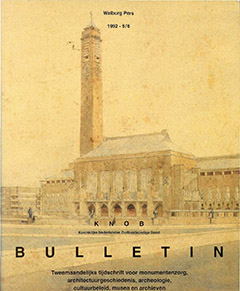Indexering ESCI / Scopus


M.A.D. van Nieuwpoort: De architectuur van Gustav Cornelis Bremer. D.J. de Vries, J.W. Bloemink en R.H.P. Proos: De proosdij in Deventer. C.A.A. Linssen: Het Maastrichtse graf van de laatste Karolinger. Lex Bosman: Een nieuw beeld van een oud gebouw. Opmerkingen over de St. Servaaskerk in Maastricht in de elfde eeuw. Eymert-Jan Goossens en Gerrit Vermeer: De 'strenge stijl' van Alessandro Pasqualini.
From approximately 1910 to 1947 the architect ir. G.C. Bremer made an important contribution to Dutch architecture. For the greater part of that period, from 1924 to 1946, he was Government Architect. Bremer's oeuvre is quite divergent in character; it does not represent any clearly defined style or specific trend. The buildings executed by him comprise traditionalist elements as well as elements of 'New Realism', depending on what views the commission in question required of him. Indeed, Bremer did not play a part in the architecture debate between the representatives of 'New Building'...
The restoration of the former deanery, the house of the 'propositus' of Saint Lebuinus's chapter and church in Deventer, resulted in an interim report of the building-historical and archaeological investigations. This Romanesque building erected around 1130 (dendrochronological date) functioned as a gate of the immunity of the church, situated along the Carolingian border of the settlement. The gate lost its function in the course of the enlargement of the town during the late 12th century.
Within the medieval town plan the gate and the house played a central part. The old core...
The notion that the Sint-Servaas church in Maastricht served as a burial chapel for the two last Carolingians in the male line, which idea is to be found, for instance, in the article by T.A.S.M. Panhuysen in Bulletin KNOB 1991, 15-24, is disputed in this article on the strength of historical source research. As far as Duke Otto (+1005/1006) is concerned, this is based on the error that Duke Karel van Lotharingen (+993) was considered to have been the last Carolingian.
There are no archaeological data or historical sources supporting the view that Duke Otto was buried in...
Extensive archaeological research took place during the recent restoration campaign of the St. Servaas church in Maastricht. A number of spectacular findings, referred to before in publications of town archaeologist Panhuysen, shed new light on existing views on the building history of the church. The greater part of the results of the research into the building history are yet to be published. Since there seldom is immediate unanimity on reconstructions of building phases when such a complicated building history as the history of the St. Servaas church is concerned, the results so far...
The architecture of the fortress engineer Allessandro Pasqualini - an Italian working in the Netherlands during the second quarter of the sixteenth century - is characteristic of the 'austere' Renaissance. This notion is reserved for a group of buildings in the Netherlands of this period, designed by Italians. Pasqualini applied the classical orders as consistently as possible in various building types. In this respect he differed radically from his mannerist Dutch contemporaries, who used classical elements in a very free and inventive fashion.
Pasqualini's sources for his...


open access mogelijk gemaakt door Stichting OpenAccess
